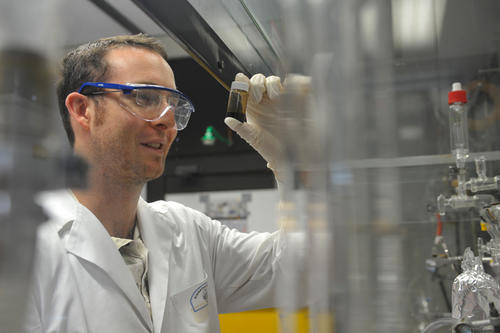Research That Gets under Your Skin
Our skin is a climate control system, the foundation for our hair, and a carrier of messages. But above all, it is an effective barrier that protects us.
Jan 06, 2014
Daniel Nordmeyer is one of the researchers in Professor Eckart Rühl’s physical chemistry group who investigate how iron oxide nanoparticles can be used as contrast agents in magnetic resonance imaging.
Image Credit: Bernd Wannenmacher
“It’s really not that simple to penetrate through the skin,” says Professor Eckart Rühl, of the Institute of Chemistry and Biochemistry at Freie Universität Berlin. Rühl should know; he studies nanoparticles that overcome the barrier formed by the upper layers of the skin and can release active medical ingredients in deeper layers.
This past spring, the German Research Foundation (DFG) awarded Rühl and his colleagues funding for their collaborative research center, one of twelve new centers to receive support. The center also includes the participation of Charité – Universitätsmedizin Berlin, the Helmholtz-Zentrum Geesthacht, in Teltow, and the University of Potsdam.
These days, patients suffering from severe forms of atopic dermatitis or psoriasis have to take very powerful medications. Cyclosporine, for example, treats skin inflammation, but it has adverse effects on kidney function in particular, can cause nausea, edema (swelling), and high blood pressure, and is suspected of contributing to cancer. Methotrexate affects the ability of the bone marrow to form new blood cells, and the active ingredient tacrolimus is also believed to increase the risk of skin cancer and cause neurological symptoms such as vertigo and vision problems.
The problem: For sufficient quantities of an active ingredient to be able to penetrate the natural barrier formed by the skin, patients either have to apply ointments or creams over large areas of the body, or the active ingredient has to be transported to the part of the skin suffering the disease via the stomach, intestines, and bloodstream. But the higher the concentration in the body is, the stronger the side effects.
But what if the effective molecules in these drugs could be packaged in such a way that they only affect the areas where they are needed? “Nowadays, chemistry has provided us with carrier systems for pharmaceuticals that make it possible to target the use of medications that narrowly,” Rühl says. The secret? So-called nanocarriers: tiny spheres that can encapsulate the medications and react to stimuli such as light or heat.
If a medication is administered in this kind of “package,” it can penetrate to exactly the root cause of the disease. “For example, the skin can be warmed. When warmed, nanocarriers can change in volume, thereby releasing the active ingredient,” Rühl explains. Changes in the acidity or basicity – the pH value – of a solution can also cause active ingredients to be released from nanocarriers. At present, 19 researchers from various departments are studying these bio-nano interactions.
“It is crucial for us to work on the concepts and foundations of this therapeutic approach. That means we are not primarily interested in developing products, but our work could certainly be used to create new products,” the chemist says.
With this in mind, the pharmaceuticals researchers contribute the best active ingredients, chemists supply their best nanocarriers, and physicists provide the best measurement methods and mathematical models. Research is conducted in cooperation with physicians, veterinarians, and toxicologists. Skin is an especially suitable subject of research in this regard. “We are highly familiar with how the skin works. It has one huge advantage: The pathways transporting substances to the treatment site are very short, and changes in skin temperature are much easier to bring about than is possible with internal organs.”
The researchers in Berlin and Brandenburg plan to work together closely with working groups in Mainz, where researchers in another newly formed collaborative research center are attempting to use nanoparticles to transport fragile substances to tumor cells and thereby destroy them. The two groups are taking considerably different approaches, but both sides hope to arrive at new findings by regularly sharing the results of their research.
“Our approaches are also being assessed in terms of toxicology – and for some substances, it may turn out that they are not usable for clinical practice,” Rühl says. “Still, we are confident that we will find concepts that work better and on a more targeted basis than skin cream.”
Further Information
Prof. Dr. Eckart Rühl, Freie Universität Berlin, Institute of Chemistry and Biochemistry, Tel.: +49 30 838-52096, Email: ruehl@chemie.fu-berlin.de

